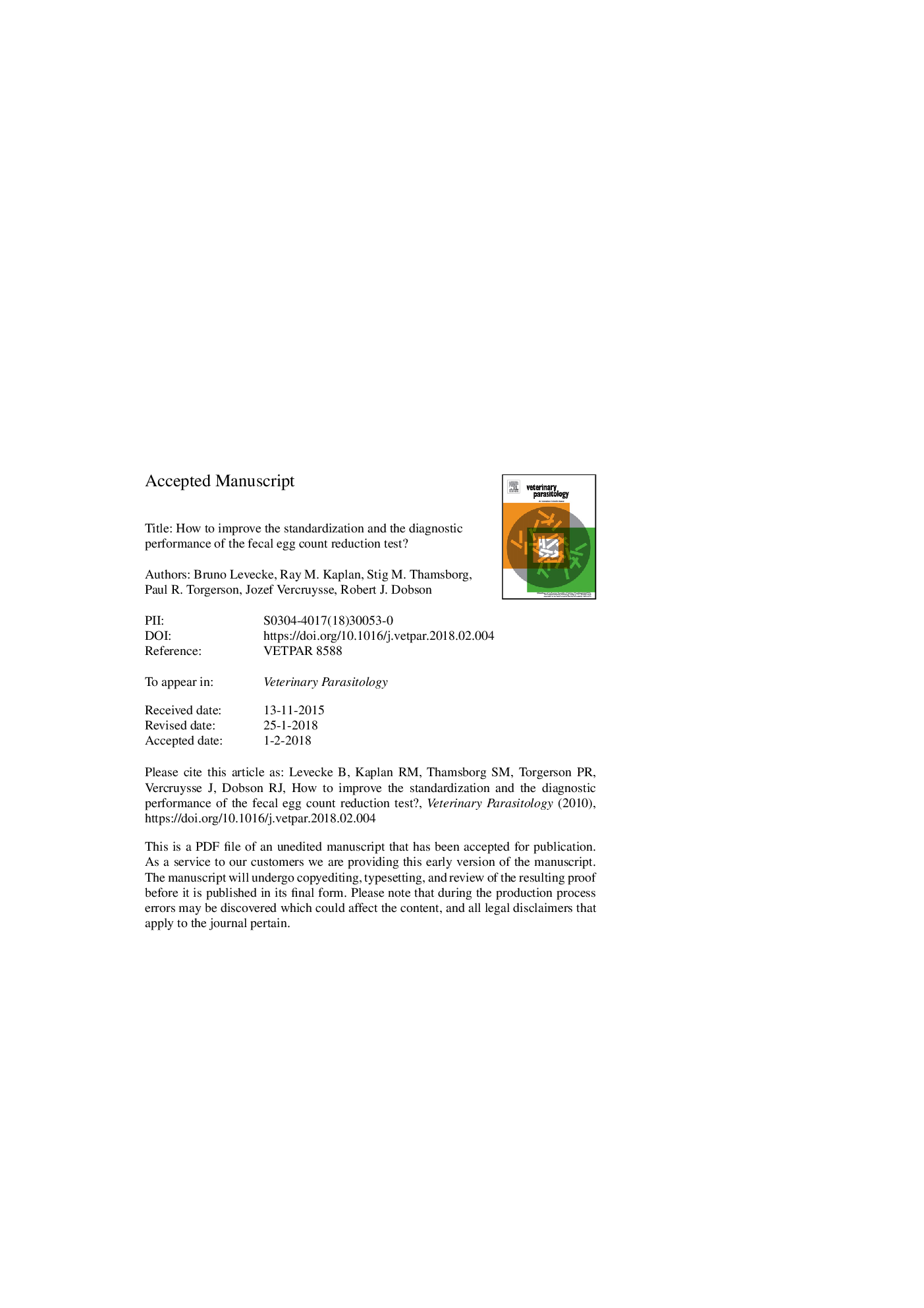| کد مقاله | کد نشریه | سال انتشار | مقاله انگلیسی | نسخه تمام متن |
|---|---|---|---|---|
| 8506064 | 1555623 | 2018 | 36 صفحه PDF | دانلود رایگان |
عنوان انگلیسی مقاله ISI
How to improve the standardization and the diagnostic performance of the fecal egg count reduction test?
ترجمه فارسی عنوان
چگونه می توان استانداردسازی و عملکرد تشخیصی آزمون کاهش تعداد تخم مرغ را بهبود بخشید؟
دانلود مقاله + سفارش ترجمه
دانلود مقاله ISI انگلیسی
رایگان برای ایرانیان
کلمات کلیدی
آزمون کاهش تعداد تخم مرغ کارآیی انتهلمینتیک، برنامه های نظارت، مقاومت ضد انفلونتیک، شبیه سازی مونت کارلو، استاندارد سازی،
موضوعات مرتبط
علوم زیستی و بیوفناوری
علوم کشاورزی و بیولوژیک
علوم دامی و جانورشناسی
چکیده انگلیسی
Although various studies have provided novel insights into how to best design, analyze and interpret a fecal egg count reduction test (FECRT), it is still not straightforward to provide guidance that allows improving both the standardization and the analytical performance of the FECRT across a variety of both animal and nematode species. For example, it has been suggested to recommend a minimum number of eggs to be counted under the microscope (not eggs per gram of feces), but we lack the evidence to recommend any number of eggs that would allow a reliable assessment of drug efficacy. Other aspects that need further research are the methodology of calculating uncertainty intervals (UIs; confidence intervals in case of frequentist methods and credible intervals in case of Bayesian methods) and the criteria of classifying drug efficacy into 'normal', 'suspected' and 'reduced'. The aim of this study is to provide complementary insights into the current knowledge, and to ultimately provide guidance in the development of new standardized guidelines for the FECRT. First, data were generated using a simulation in which the 'true' drug efficacy (TDE) was evaluated by the FECRT under varying scenarios of sample size, analytic sensitivity of the diagnostic technique, and level of both intensity and aggregation of egg excretion. Second, the obtained data were analyzed with the aim (i) to verify which classification criteria allow for reliable detection of reduced drug efficacy, (ii) to identify the UI methodology that yields the most reliable assessment of drug efficacy (coverage of TDE) and detection of reduced drug efficacy, and (iii) to determine the required sample size and number of eggs counted under the microscope that optimizes the detection of reduced efficacy. Our results confirm that the currently recommended criteria for classifying drug efficacy are the most appropriate. Additionally, the UI methodologies we tested varied in coverage and ability to detect reduced drug efficacy, thus a combination of UI methodologies is recommended to assess the uncertainty across all scenarios of drug efficacy estimates. Finally, based on our model estimates we were able to determine the required number of eggs to count for each sample size, enabling investigators to optimize the probability of correctly classifying a theoretical TDE while minimizing both financial and technical resources.
ناشر
Database: Elsevier - ScienceDirect (ساینس دایرکت)
Journal: Veterinary Parasitology - Volume 253, 15 April 2018, Pages 71-78
Journal: Veterinary Parasitology - Volume 253, 15 April 2018, Pages 71-78
نویسندگان
Bruno Levecke, Ray M. Kaplan, Stig M. Thamsborg, Paul R. Torgerson, Jozef Vercruysse, Robert J. Dobson,
